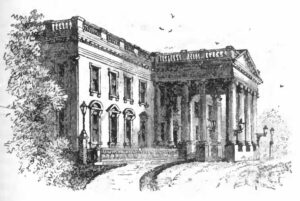
After the civil war, American First Ladies were women with direct experience in the social movements of their time. As young women, none had any expectation of the office they would hold, but their role as presidential spouses continued to bring change to the White House.
The Election of 1876
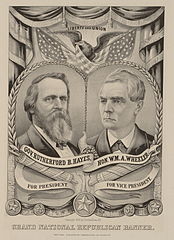
After eight years in the White House, President Grant declined to run for a third term. The Republican Party nominated Governor Rutherford B. Hayes of Ohio. The Democrats put Governor Samuel J. Tildon of New York on the ballot.
The first voter tally showed Tilden with 184 electoral votes and Hayes with 165. However, twenty electoral votes from four states were disputed. The issue was hotly debated until politicians worked out what is called the Compromise of 1877. Democrats agreed to give the 20 electoral votes to Hayes, in exchange for the Republican promise to withdraw Federal troops from the southern states, effectively ending Reconstruction.
Lucy Ware Webb Hayes aka Lemonade Lucy
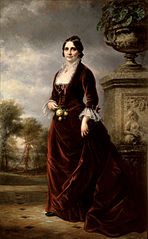
Lucy Hayes was the first presidential spouse with a college degree. Prior to the civil war, she supported abolition, temperance, and women’s rights, stating that a woman was man’s “equal in all things and his superior in some.”
Lucy first met her husband when she was a 14-year-old student at Ohio Weslyan University. They met again when she was 19. The couple married in 1852 and had eight children. During the war, Hayes commanded the 23rd Ohio Volunteer Infantry. Like Julia Grant, Lucy joined her husband in camp, nursing men and helping in other ways, earning her the title Mother of the Regiment.
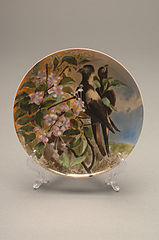
After the war, Hayes served a term in Congress and was elected governor of Ohio for three terms before assuming the presidency. To keep down expenses, Lucy retrieved furniture stored in the White House attic and arranged it in a way that hid holes in the carpet and drapes. In place of furnishings, Lucy requested a new set of White House china designed by Theodore Davis with scenes depicting American flora and fauna.
The White House received two major improvements during Lucy’s tenure: bathrooms with running water and a wall telephone. Progress! Another innovation Lucy introduced was the now annual Easter Egg Roll on the White House lawn the Monday after Easter.
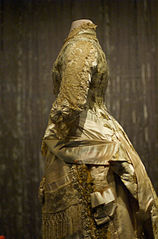
At President Hayes’ first official dinner, Lucy served wine with the meal. However, the six wine glasses at each place setting angered Temperance supporters. The president knew the Republican party needed the temperance vote, and banned all alcoholic beverages from future White House functions. Many mistakenly thought he made the decision under Lucy’s teetotal influence. Despite the “dry” White House, Lucy was a popular hostess, later referred to as Lemonade Lucy.
Lucy was the first presidential spouse to publicly support causes such as adequate funds for mental health care and encouraging women to pursue higher education. She did not, however, support women’s suffrage.
Rose Elizabeth Cleveland
Grover Cleveland was a bachelor when he entered the White House in 1885, though he had fathered a child out-of-wedlock. Necessity and scandalous baggage made Grover’s sister Rose a good choice for the office of First Lady.
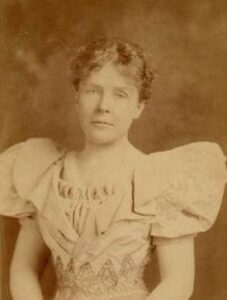
Rose, nicknamed Libby, was a teacher and freelance lecturer who was bored by small talk and known for conjugating Greek and Roman verbs in her head while attending public White House receptions. But though she thought women paid too much attention to fashion, Libby’s fashion choices were less than demure. According to The New York Times Libby attended a March 1885 reception wearing “a dress of black satin, with entire overdress of Spanish lace. The satin bodice was low cut and sleeveless and the transparent lace revealed the shoulders and arms.”
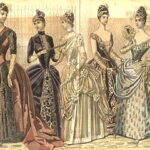
Libby’s clothing led to an 1886 public exchange of letters in the New York World. Elizabeth Cady Stanton, a leader in the women’s suffrage movement, wrote “the custom of partially denuding innocent girls in public is carried to the verge of immorality.” To which Libby responded “I approve of evening dress which shows the neck and arms. I do not approve of any dress which shows the bust. Between the neck and bust there is a line always to be drawn and it is as clear to the most frivolous society woman as to the anatomist.”
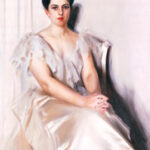
In 1886, Grover married his 21-year-old ward Frances who became the youngest wife of a sitting president, and Libby returned home to Massachusetts. About 1889, Rose met Evangeline Simpson. The couple began a correspondence and spent time in each other’s homes. In 1901, after Evangline’s second husband died, Libby and Evangeline took up residence in Bagni de Lucca in Tuscany.
Edith Galt Wilson
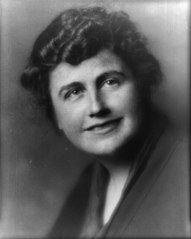
In March 1915 Edith Galt, a widow, met President Woodrow Wilson, a lonely widower whose wife died of Bright’s Disease in July 1914. Edith and Woodrow married in December 1915. As First Lady, Edith remained by her husband’s side as he worked at his desk in the family quarters and sat in on his meetings. After the U.S. entered World War I, Edith had access to classified information.
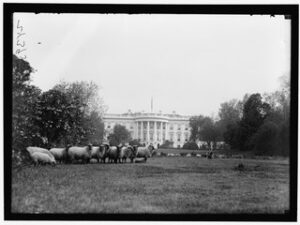
As First Lady, Edith threw herself into the war effort, observing Gasless Sundays, Meatless Mondays, and Wheatless Wednesdays. She even decided to save money on mowing the White House lawn by grazing sheep and auctioning their wool, with the proceeds going the Red Cross. Edith joined her husband when he went to Europe to visit American troops in 1918 and later to the Paris Peace Conference in 1919.
Shortly after returning to the United States, Presient Wilson embarked on a national campaign to gain support for the League of Nations and the Versailles Treaty. While on tour, Wilson collapsed from exhaustion and returned to the White House in late September. On October 2, Edith discovered her husband unconscious on the bathroom floor. He had suffered a massive stroke.
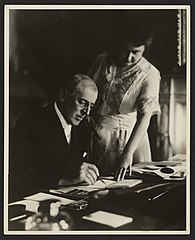
Edith decided to act as her husband’s steward. She and his doctors hid the extent of Wilson’s disability from Congress and the public, stating he suffered from exhaustion, needed to rest, and was working from his bedroom. Edith guarded all access to the president. She screened his communications and only took matters she considered important to the president.
Edith continued her stewardship for the remainder of her husband’s term of office. In this 1921 picture, Edith holds down the document for the president’s signature. Woodrow’s left side remained partially paralyzed from his stroke.
🐑 🐑 🐑
Illustrations
Drawing of White House published in 1891 in Appleton’s Cyclopaedia of American Biography.
Hayes-Wheeler Campaign Poster 1876.
Lucy Hayes. Portrait by Daniel Huntington, 1881.
Hayes Presidential China Plate.
Lucy Hayes Reception Gown. Smithsonian Institute. Photo by Jeff Kubina.
Rose Cleveland.
Fashion Plate, 1888. Peterson’s Magazine.
Edith Wilson assists President Wilson signing a document 1921
Gillian Brockell. “A Gay First Lady?” Washington Post. June 29, 2019.
Rob Hardy. “The Passion of Rose Elizabeth Cleveland.” New England Review. Vol. 28. No. 1. pp 180-193.
National First Ladies’ Library
National Museum of American History: First Ladies
First Ladies of the United States. National Portrait Gallery.

Sandra Wagner-Wright holds the doctoral degree in history and taught women’s and global history at the University of Hawai`i. Sandra travels for her research, most recently to Salem, Massachusetts, the setting of her new Salem Stories series. She also enjoys traveling for new experiences. Recent trips include Antarctica and a river cruise on the Rhine from Amsterdam to Basel.
Sandra particularly likes writing about strong women who make a difference. She lives in Hilo, Hawai`i with her family and writes a blog relating to history, travel, and the idiosyncrasies of life.

